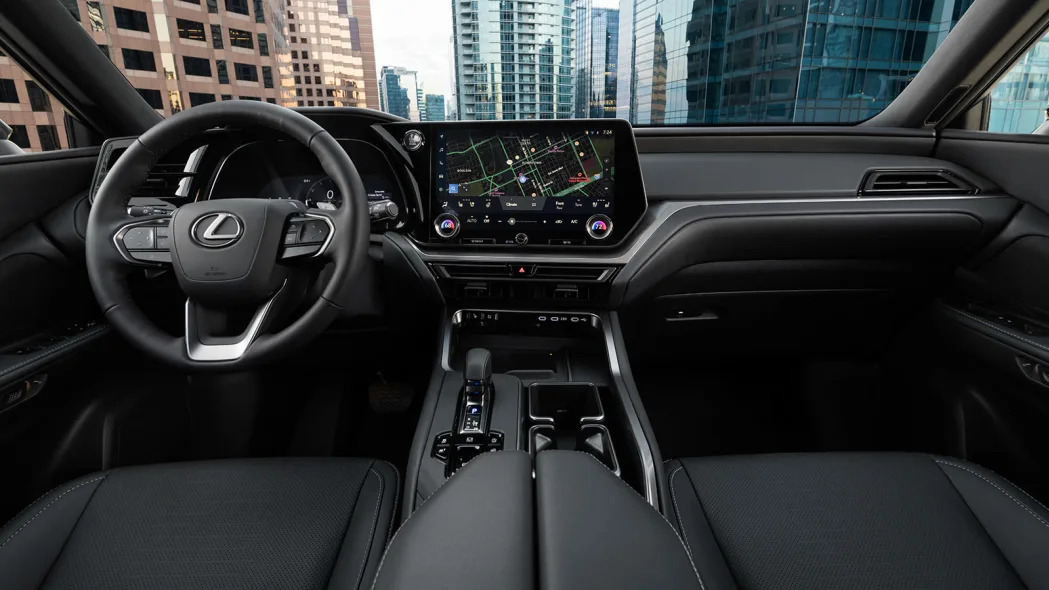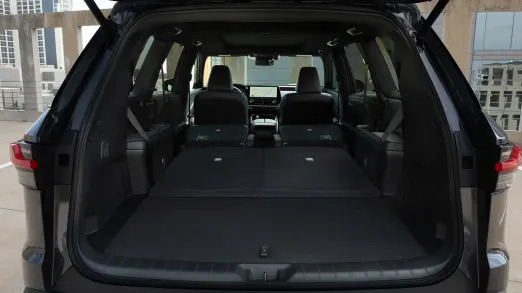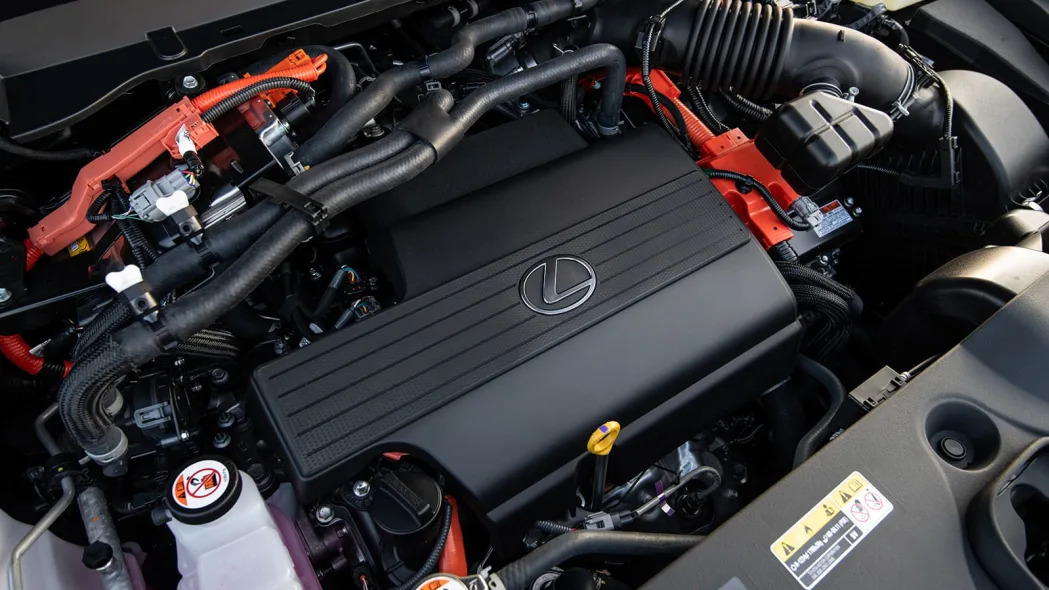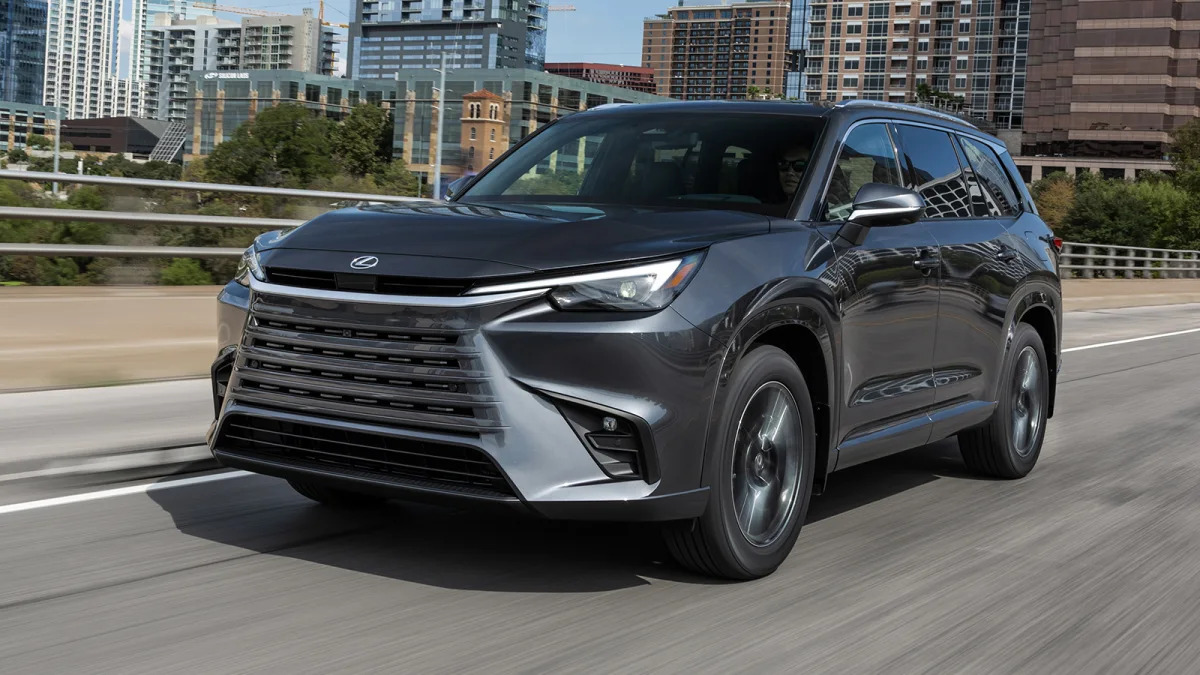AUSTIN – In a world where most luxury automakers have introduced plush, smartly designed, road-oriented three-row SUVs, Lexus has, strangely, not. While it has literally offered SUVs with three rows, the rearmost one has never been especially useful. In the case of the LX and GX, it’s been a sort of bonus feature for the luxury off-roaders, while the one in the now-discontinued RX L’s had a certain “best we could do under the circumstances” feel to it. The new 2024 Lexus TX, on the other hand, has the real deal. Based on the Toyota Grand Highlander, the TX is a space efficient, fuel efficient, and road-ready luxury three-row SUV that is certainly worth your time. At least, the hybrid ones are.
Unlike the Lexus NX, which you’d be hard-pressed to tell is a RAV4 underneath, the TX is more obviously related to the Grand Highlander. Still, Lexus did a solid job restyling Toyota’s also-new three-row crossover. The exterior's lines have been softened, save for the front fascia that adopts the angular, grille-centric looks of other Lexus models. The partial floating roof look created by the blackout D-pillar and the full-width taillights complete the exterior transformation. The interior is arguably more impressively reimagined. The dashboard and door panels are completely different, and if you've been in the new RX, you've seen it all before. The main attraction is a piano black monolith that houses an instrument cluster screen and 14-inch infotainment screen with Toyota's current operating system. Those door panels also feature the electronic door handles Lexus has been rolling out.
Dash materials vary based on the trim. All of them are certainly quality, and well-assembled, though the base versions don't feel much fancier than what you’d find in the Grand Highlander. The suede-like materials available on higher trims definitely elevate things. The front seats follow a similar pattern. The base seats are fine with fairly soft cushioning, but they're lacking in support and adjustments. Optional seats available on higher trims, particularly the ones with adjustable thigh supports, are superb and well worth picking up. Head- and legroom are good up front, with the former being improved if you opt out of a sunroof. Knee room side to side is a little snug at first blush, but won't be noticed once you're settled in and driving. As is typical, the seats get progressively firmer and flatter going from front to rear. The second row has plenty of room in every direction, and the third row is actually tolerable for fairly tall adults or teenagers. If nothing else, that makes the TX a more viable three-row vehicle for more families – not just in comparison to past Lexus offerings, but the entire luxury landscape as well. Those with actually habitable third rows are few and far between, unless you want to spend close to $100,000 for something like a Mercedes GLS or Lincoln Navigator.



Mechanically, the TX is quite similar to the Grand Highlander, but with a number of notable differences. The entry-level TX 350 gets the same basic powertrain as the regular Grand Highlander with a 2.4-liter making 275 horsepower and 317 pound-feet of torque, which is slightly more than the Toyota thanks to new tuning for premium fuel. It sends power through an eight-speed automatic transmission to either just the front wheels or all four, and both drivelines deliver 23 mpg combined. And the experience with this powertrain is pretty much like the Toyota. The engine has excellent, easily accessible torque that's perfect for shunting around the approximately 4,500-pound SUV with ease. It is still a bit coarse sounding, but it has enough sound insulation to keep it in check. The transmission is far smoother than the engine, good for luxury cruising. The suspension is fixed in tuning and it’s expectedly soft, but well-controlled. It does lean a fair bit, but responds well to steering inputs, and the steering itself is nicely weighted with even some feedback. Not much, but more than you might expect.
The hybrid powertrains are where things start to change. Instead of the meagerly powered but extra-efficient “classic” hybrid offered by the Grand Highlander and Lexus RX 350h, the base gasoline-electric choice, found in the TX 500h, is the Hybrid Max powertrain shared with the RX 500h and range-topping Grand Highlander. The front wheels are powered by a combination of 2.4-liter turbocharged inline-four, conventional six-speed automatic and a 64-kilowatt electric motor sandwiched between them within a clutch pack; a 76-kilowatt motor powers the rear wheels through what Lexus calls its eAxle that can proactively engage based on various parameters instead of simply reacting to front-wheel slippage (as the standard Toyota/Lexus hybrid all-wheel-drive system does). Output is 366 hp and 309 lb-ft of torque, which is just a hair better than its Lexus/Toyota siblings. Fuel economy estimates of 27 mpg combined are equal to the Grand Highlander’s.
This is just as pleasing a powertrain in the TX 500h as it is elsewhere, with a deep intake sound (which does seem to be artificially enhanced), few shifts interrupting power delivery, and, well, plenty of power.

The other hybrid option is the TX 550h+. Its plug-in hybrid powertrain is not shared with the Grand Highlander and although similar in concept to what’s found in the RX 450h+, it boasts a 3.5-liter naturally aspirated V6 in place of a 2.5-liter NA inline-four. Its lithium-ion battery pack (instead of the nickel metal hydride one found in the 500h) can provide an estimated 33 miles of EV-only range and, along with its twin-motor transaxle, contributes to a total system output of 404 horsepower. Torque numbers haven't been given.
In EV mode, the electric motors provide beautifully smooth propulsion that will get it to highway speed just fine. But as they aren't the sole source of forward movement, they do feel a little underpowered at full-throttle. With the engine engaged, it actually feels pretty much like the TX 500h's powertrain. That's probably more a testament to how well Lexus tuned the sound and power of the 500h, rather than anything bad about the V6. And while the 550h+ has nearly 40 more horsepower, it doesn't feel much quicker due to the extra weight (5,357 pounds versus 4,949). As such, the main reason to get the 550h+ is for the fuel economy. It has the best combined rating of 29 mpg, but you should be able to do much better than that if you routinely plug it in – and why wouldn’t you?
Suspension design is mostly the same as the Grand Highlander with the Hybrid Max, but the TX hybrids get the adaptive shocks and rear-wheel steering offered by the RX. These make a significant improvement in handling, offering much less body roll and more eager cornering when in sport modes than a regular TX or Grand Highlander. And in the normal modes, it's just as cushy over bumps. The steering oddly feels a bit more numb and light than the base model, though. Still, the other improvements in driving would still leave us preferring the hybrid models.

Overall, the Lexus TX is a very good three-row SUV because the Grand Highlander is also a very good three-row SUV. That presents a bit of a problem, however. The base price for the TX 350 is $55,050, which is about $10,000 more than a base Grand Highlander. That leaves plenty of room for options and higher trims, and with how similar it is to drive and the small gap in interior fanciness, we'd honestly suggest opting for the Toyota (or a Kia Telluride). Fortunately, the hybrids offer so much more in the way of comfort, handling, performance improvements and uniqueness that they make a strong case for themselves, even at higher prices of $69,350 for the TX 500h and an undisclosed higher charge for the TX 550h+. That’s actually not bad considering that similarly priced three-row luxury SUVs are less practical, while similarly spacious ones can push $100,000 or more.
So there you have it, provided you're getting one of the hybrid Lexus TX models, you're getting a luxurious three-row SUV that does everything well. It's spacious, efficient, powerful, comfortable yet decent in corners. And most important, it fits this niche better than anything Lexus has tried to shoehorn into it previously.
Related video:










Sign in to post
Please sign in to leave a comment.
Continue